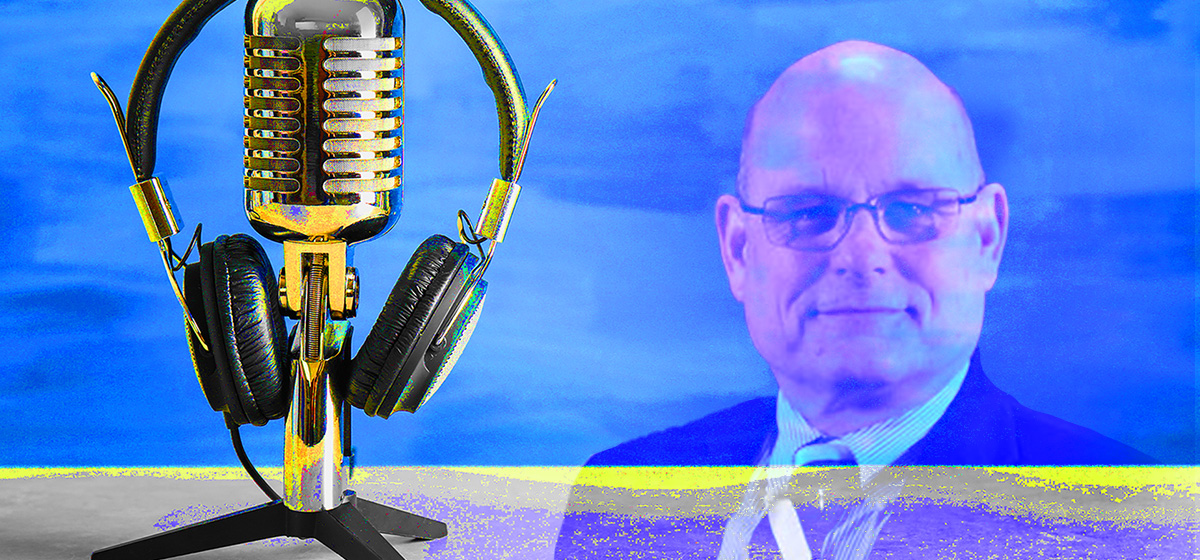Rust Belt to Digital Belt: Re-Tooling Communities and Students for the Future

Donald Bonk interviews Kevin Snider, chancellor of Penn State New Kensington, as part of the Pittsburgh Tomorrow podcast series. This interview was conducted before COVID-19. The transcript is abridged and edited for clarity.
View the episode archive here. View Kevin Snider’s LinkedIn profile here.“We have a role to play in figuring out how you take these communities around Pittsburgh and get them to tap into the digital age, and be connected to Pittsburgh in ways that we probably haven’t even envisioned yet.” —Kevin Snider, chancellor of Penn State New Kensington
Donald Bonk: Kevin, tell us a little about yourself.
Kevin Snider: One of the things that people probably don’t know is that I grew up overseas. I spent four years in Nigeria and two years in Malawi, a year in boarding school in England. I was adopted in Canada. I went from Africa to Moscow, Idaho, of all places, to Fresno, California, to San Francisco, to D.C., to Terre Haute, Indiana, where I was employed by Indiana State University and rose up to be chief of staff there, before moving here to New Kensington to be chancellor of the campus.
One of the things that has been the secret to my success, is that I really started in a (university) administration in institutional research. I have a data analytics background. I’m used to looking at data to try and predict trends and figure out solutions and directions. I found that to be very successful throughout my career, but also in helping us decide what we’re going to do here in New Kensington.
We’re part of the higher education community, which in Pittsburgh is a tremendous asset to the region. You and I have talked before about the role that Carnegie Mellon has played in developing new technologies and new innovations and their place in robotics, and how that’s bringing in companies and people. That’s kind of what I think the Allegheny Conference has seen as well.
Pitt is doing the same thing, not quite in the same way that Carnegie Mellon has. Our effort here in New Kensington is to focus in on how to translate those innovative advancements, that kind of energy, into the smaller communities around the region.
Our hope is that we can be an example of how to do that. If the Allegheny Conference vision is correct and we do achieve 70,000 additional jobs, we’re going to need every person we can get, from every area that we can, to participate in that economy, fill those jobs, be as prepared as possible for a world that has changed, and be flexible, because those jobs are not going to stay the same.
They’re not going to be the same job five years from when they were created. We have a role to play in helping to work with our colleagues in higher education to prepare students for that world. And we have a role to play in figuring out how you take these communities around Pittsburgh, and get them to tap into the digital age, and be connected to Pittsburgh itself in ways that we probably haven’t even envisioned yet.
I’ve been all over the world. Pittsburgh has the greatest attachment to the area of its population, that I’ve ever seen. I have never been in a place where virtually almost every one of my students wants to stay in the Pittsburgh region. I’m usually in locations where people want to leave. They want to go out and explore the world. Students here do want to go out and explore the world, but they view this as home and the place that they want to come back to.
Often I hear, when we talk about economic revitalization, that all we need to do is get people to move back. There aren’t enough of us. We’re going to have to convince new populations to also move here. To do that, we have to be more inclusive of people of diversity, but also more inclusive of people that aren’t from here.
Bonk: Can you give me three thoughts, ideas and policies that you think would make a difference for Pittsburgh to realize its full potential in the future?
Snider: Sure. One is absolutely working on inclusion and dealing with some of the some of the perceptions of people that are different from us, that exist in this region, and that are pretty pervasive.
The second is transportation. We’ve got to figure out a way to physically connect people from these regions to Pittsburgh. We’re 17 miles away from Pittsburgh, and the population that we want to attract, are people that don’t want to own cars. They don’t want to sit in taxis. They want environmentally-friendly ways of getting from the core to the outreaches, and from the outreaches to the core. So, transportation is tremendous.
The third is, in my opinion—this is self-interested—that we have a real opportunity to use the 20 college campuses in the area, to really be more attractive magnets for people from outside of the area to come here. What we need to do is figure out ways for those students that do come here, to get them attached to the community.
Bonk: Do you have any creative or interesting thoughts around population gain, loss, or connections?
Snider: I’m not sure that we are in as dire a circumstance in terms of the gap between the population that we have, or are projected to have, and the number of jobs available, as we had thought when I first came here 12 years ago. The reason is automation. Automation is going to change the way that we think about our notion of work. We’re already seeing it.
More and more people are staying home, working from their computers, working online, collaborating across the planet from their living rooms. But also, more people are having to deal with automation in ways that they had never anticipated, even 12 years ago. Getting a population that can integrate, and know how to use, and know how to interact, know how to be productive around the technology, is something that we’re trying to create here through our Nextovation effort.
It’s something that means that we won’t have to have as many people. The fact that there are so many players that are so invested in place, that are so invested in moving the city and region forward, and caring about the people that are here, and working collaboratively together, and that have this innovative spirit, gives me tremendous hope.
Bonk: The need for Pittsburgh to become more diverse, more inclusive and more respectful of different ways of thinking, is vital to us winning.
Snider: It is. The largest growing populations in this country are not white Anglo Saxons. If we really do need 70,000 additional people for the jobs and we want to attract them, we’re going to have to attract populations that are growing as well. Finding ways to incorporate them is going to be really important. What gives me tremendous hope in that sphere, is that there are a lot of people that think the same way, and are working toward that and with the amount of innovation we have in this area, I just see a really bright future.
The Launch Box initiative is a statewide initiative through Penn State, that is focused on trying to stimulate economic revitalization in local communities, primarily rural and rustbelt communities, which is where most of our campuses are, through entrepreneurship. We have seen what entrepreneurism and innovation has done for neighborhoods like East Liberty and now Lawrenceville and Bakery Square.
When Google came to Bakery Square and made that announcement, you started to see people that are in innovation, gravitate toward that location. It became a magnetic location. I call it an intellectual magnet. That intellectual magnet has really kept on through coworking space, through entrepreneurship programing, incubators and accelerators and through what was the tech shop maker space. It kept a lot of the energy in that area.
The idea was, could we as a university play the role of being the intellectual magnet and build a scalable economic ecosystem that would be able to attract innovation into these downtown areas, spawn new businesses, and have those come out and create the same kind of energy?
We partnered with Beauty Shoppe, which is a coworking space in Pittsburgh out of East Liberty, and they really have a great sense of how you use coworking and entrepreneurism to benefit a community and help develop this revitalization sphere. When we talked to them, they said, “If all you do is bring people in and out of your center, you haven’t done anything. You need to make a walkable street and you need to encourage people to walk up and down in town, and go to the shops there.”
When we did that, we called it the corridor of innovation. When we called it the corridor of innovation, we got two things. One was that we got attention from places like Carnegie Mellon, but most more particularly in our case, Penn State, to come in and do research on Rust Belt issues that are dealing with innovation and that whole Rust Belt journey to a better time. In this case, it was roofs. We had a couple of research teams come in and look at roofs.
In these small rust belt towns, nobody takes care of roofs. We have a prototype that now we’re going to put up and see if we can give to students to turn into a business—not to take away from roofing companies, but just to be able to cover people that have leaking roofs. We’re losing infrastructure all over the Rust Belt. We can protect that infrastructure and give those buildings a chance to be revitalized.
The other thing it did, was it brought in businesses and major companies like Siemens and our Arconic, who wanted access to ideas and they introduced us to industry 4.0. And when they introduced us to 4.0, the whole world changed.
Industry 4.0 is an interesting concept. It came out of Germany. It has to do with a whole new way of doing business. If you remember, Industry 1.0 is about mechanization and steam power and the weaving loom, and then industry 2.0 was about mass production and assembly lines and things like that. Remember the workers in the 1950s standing on lines and putting cars together.
Then industry 3.0 was about automation: fewer people on the lines doing things, the robotic arms. Computers and electronics came in.
Industry 4.0. and what has taken this into a whole new era and is the pace and acceleration of technological impact and Moore’s Law, the doubling of knowledge every 18 months, as well as the availability of that information on the web.
So the Internet of Things, the ability to access huge amounts of data, process them in computers that are faster and more effective. The way the companies explained it to me is that they are looking for intrepreneurs.
When we talk to these companies about what an Intrepreneur means, it means someone who is transparent, someone who’s collaborative, someone who knows how to be innovative. And oddly enough, one of the greatest things is someone who knows about failure.
Failure is part of a process to an entrepreneur. It’s not an end. To a small business person, if you fail, you’re done right. Game over. Now, for an entrepreneur, if you fail, you learn and you move on. And it’s part of the continual process. And companies need those four traits in order to become as effective as they can in this industry 4.0 sphere.
They need to become entrepreneurial minded. They’re going to have between four and 11 careers over the course of a lifetime. Not jobs, but careers. They’re continually going to have to pivot. They’re going to have to face a world in which robotics and automation and the Internet of Things and artificial intelligence will increasingly encroach on their functions. They have to figure out how to use that technology. They have to know what those technologies are.
Then finally, they have to figure out how to use soft skills, the ability to communicate, the ability to think creatively and problem solve, emotional intelligence. They have to do those things in that environment; in that technology laden environment that is fast-paced.
We have to change what we’re doing for students. Oddly enough, when we started to think about this, we thought about, if what we’re doing in New Kensington is building an ecosystem that produces businesses that just get on Main Street and aren’t attached to the digital world, to Industry 4.0, then how are we going to revitalize that region?
If you have a town, a city, an area, a rust belt of a rural belt that’s not competing effectively in Industry 3.0, how do you get them to compete in Industry 4.0? And so are our initiative in New Kensington became less about less spawning individual businesses and ideas to fill shops and places. We think that will come anyway. It became more about how you take a rust belt into the digital belt.
If I had to kind of define Nextovation, it would be the process of introducing and acclimating a population, a community, to the digital age.





